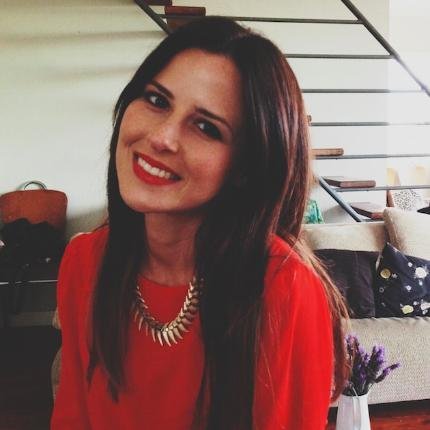
Is branded entertainment just a fad? Or is it a key part of the new age of advertising?
 ?Buzzwords floating about the marcomms industry right now include integration, branded content, sponsored content, brand-funded content, production partnerships and the A-word (advertorial).
?Buzzwords floating about the marcomms industry right now include integration, branded content, sponsored content, brand-funded content, production partnerships and the A-word (advertorial).
I tend to prefer the term branded entertainment – purely because it places emphasis on entertainment, which is in essence where the equity comes from.
Is branded entertainment just a fad, a trend, a nice-to-have? Or is it a crucial change necessary for advertising’s relevancy in the future? It seems to be that all of the top ad awards are creating bespoke categories set aside for this new concept. And brands are now taking out awards from film festivals and the likes of One Show in Los Angeles – awards that were traditionally reserved for entertainers and storytellers.
This leap to branded entertainment concepts has even impacted media on New Zealand shores with the likes of the NZ Herald, Mediaworks, TVNZ, and NZGirl all creating integration media capabilities in the last few years. With branded entertainment properties such as The Block, The Cadbury Dream Factory, and even on StopPress, with Autotrader bringing us StopGear.
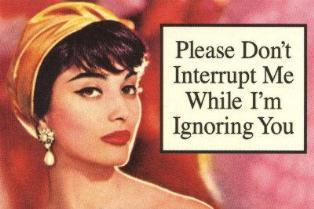
It’s obvious that the change in media consumption is what’s driving the need for branded entertainment. The fast-forwarding technology for TV and the vast array of digital content platforms have limited the power of broadcast media. However, the most important change is to where the power has shifted – the consumer.
No longer can we as advertisers easily interrupt consumers’ lives; we have to get permission from them in order to engage with them.
Take away the third person perspective for a moment and consider your own media consumption. We’re time poor and we select what we view based purely on entertainment value. We’re exposed to so many messages, but we individually choose a few based on the content and who it was recommended/shared/published by.
The good news for marketers is that media and creativity are coming together. And it gives us the opportunity to target and engage our consumers based on tone-of-voice, as opposed to broad-demographics. Using a wider array of channels, such as a celebrity, a journalist, a filmmaker or a TV channel, the opportunities to co-create branded entertainment are endless.
Building entertainment brands
Consider the possibilities when partnering with a non-competing brand as a media channel, tapping into the partner brand’s equity. For example, Lexus uses Coach for it’s leather seats. Nike + iPod are synonymous. McDonalds using Tegel chicken. And regardless of how it tastes, the L&P and Whittakers co-branding partnership was genius.
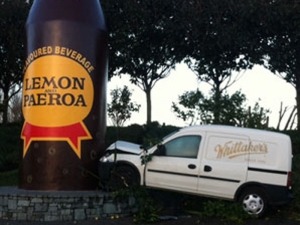
As advertisers, we call all of this ‘media planning’, but it really is distribution that we’re talking about: how to effectively deliver our brand to consumers. Therefore, if advertising has become entertainment, and media is just distribution we aren’t really that different from any other entertainment category at all; be it movies, books, or music. We shouldn’t stop at creating branded entertainment, but actually start building entertainment brands, emulating the likes of Disney or Buzzfeed.
Last year I was in San Francisco watching Emirates Team New Zealand race against Prada in the Louis Vuitton Challenger Series. To continue our education of American culture, we bought tickets to America’s favourite pastime, baseball. I had a bag of shelled peanuts, an oversized finger pointing mitt and a Fox Sports ‘understanding baseball’ site loaded on my iPhone, and as we passed through the gates of AT&T Park, there were GO GIANTS banners being handed out to everyone. And right there on the reverse in bold; ‘KIA ORA, from New Zealand’. So much for that ‘American’ experience!
We’d managed to pick the one game that Air New Zealand had fully taken over. They gave fans a ‘Kiwi’ experience and demonstrated just how close New Zealand and San Francisco actually were in culture and in proximity – complete with All Black appearances, prizes of return trips to New Zealand and videos up on the big screen making satirical similarities between the two cultures (including the embarrassing New Zealand accent that is so prevalent when abroad).
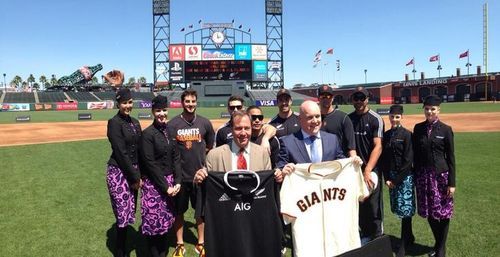
Air New Zealand has obviously been a front-runner example in utilising the value of building an entertainment brand. For example, the Hobbit partnership, their Love is in the Air promotion to celebrate legalising same sex marriage, and their inflight safety videos we’ve come to know and love. And all of which have not just entertained, but tied in seamlessly to their own business objectives. In San Francisco, they leveraged an existing conversation around the America’s Cup, and told 40,000 San Franciscans just how close and accessible New Zealand actually was, using the ‘channels’ they already love and engage with – baseball.
That’s branded entertainment at its best. You’re either unaware, or you just don’t care that it’s an ad – because you’re entertained.
(Now’s probably a good time to also point out that in this post alone, you have already willingly been exposed to roughly 36 brands.)
Here’s how I visualise the various equity models for media placement:
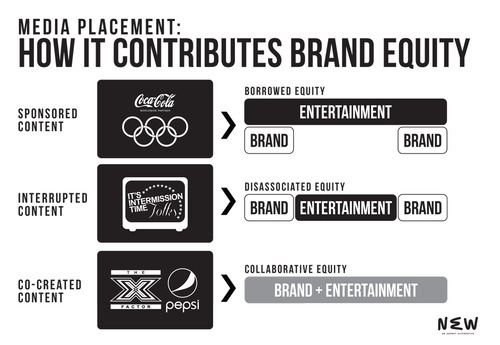
Brands as storytellers
The idea of putting brands into the content instead of separate to it has become essential to building brand equity. To be heard is to be a part of the story, written into the script and partnered with the dialogue.
And with this desire to be inside the content, we have to partner with the content makers, the storytellers, the producers, the editors – the ‘distributors’ and co-create with them. On one side of the line you have advertorial, where the editorial and entertainment value has been diluted. And on the other side you have no brand association whatsoever. But walk the fine line collaboratively and you can create something almost magical.
The key to this balancing act? Realising that consumers, not content, are kind. We have to place the consumer at the forefront of anything we create, becoming storytellers in the process.
One of my favourite examples is ‘Celebrities Read Mean Tweets’ – the partnership between Jimmy Kimmel Live and Twitter. The programme promotes Twitter in a way that feels absolutely genuine to the tone of Jimmy Kimmel and undoubtedly entertaining to his audience also.
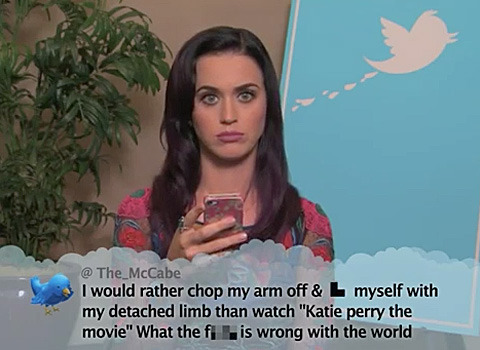
To summarise and to share, here’s the process that I use with clients to help them build their entertainment strategy:
1. Listen for the conversations already being had about your brand – this is your starting block.
2. Find premium storytelling partners that already know how to engage your target audience. It could be a filmmaker, a celebrity, or a TV channel or even a non-competing brand.
3. Create a story for your brand that is authentic to your storytelling partner and relevant to your audience. Ensuring that you focus on telling a story, not the moral of the story.
4. Consider the natural response of your consumer, and how you can encourage their advocacy and trial.
5. Build programmes that extend the story through earned, paid and owned media.
The best storytellers are also the best listeners. And I think Vanilla Ice says it best:
Stop. Collaborate. And Listen.
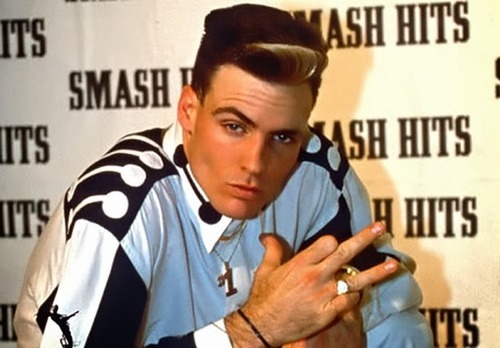
Nic Winslade is the founder of branded entertainment consultancy N E W. Her work has been recognised at Cannes, One Show Entertainment Awards, and the inaugural Branded Entertainment Awards in Australasia




